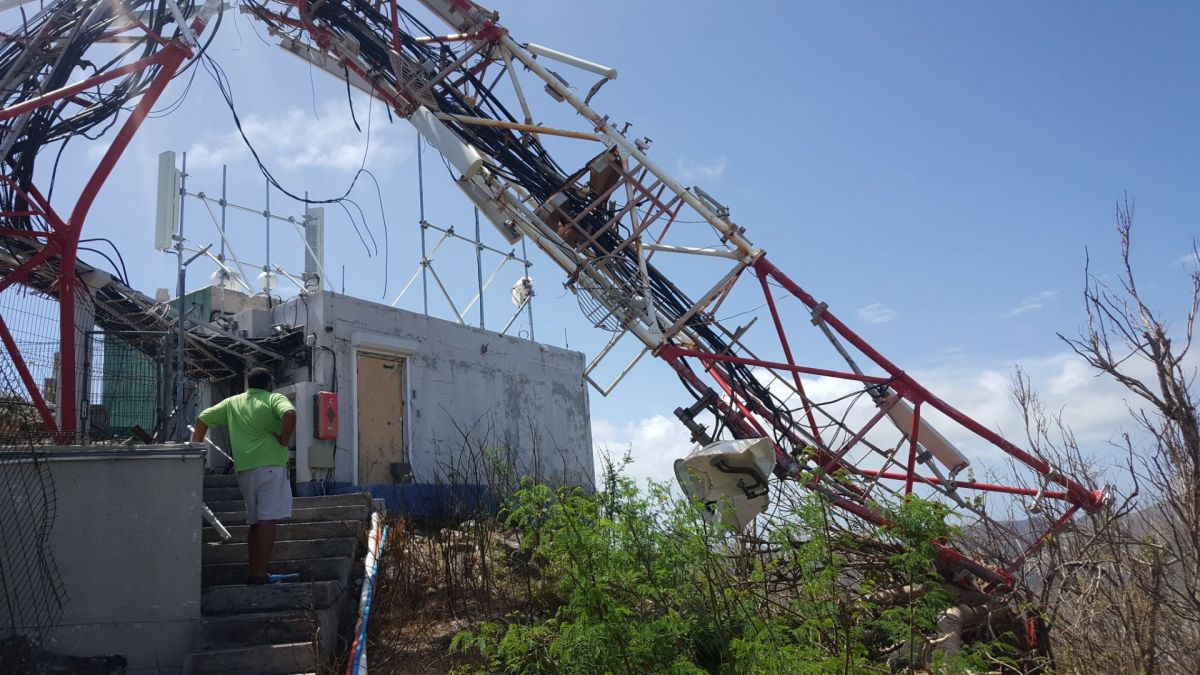
“One infrastructure” – most efficient way to restore Telecom
Published on: Oct 19, 2017
On September 6th 2017, Sint Maarten got struck by a Category 5+ hurricane with wind gusts up to 221 mph. As a result 13 major cell towers came down, over 30 micro cell sites were severely damaged, and in total close to 65% of the Telecom networks on Sint Maarten were compromised. Due to these major infrastructural damages, phone-, internet-, broadcasting-, and trunking services were jeopardized or limited available in the Irma aftermath.
In rebuilding telecom infrastructure on Sint Maarten, major investments needs to be made, and Bureau Telecommunications and Post St. Maarten (BTP) have been proactively reaching out to Telecom operators and Service Providers to gather additional and find out where BTP can assist with restoration efforts.
Director of BTP Anthony Carty explained: “based on the magnitude of the disaster and the damage assessment that we’ve executed for the Telecom industry, we do not believe that doing all restoration efforts on your own as a communication provider is the best way to move forward. Now, more than ever we feel the need for far-reaching collaboration between the Government, Regulator & Communication Providers”.
BTP has always been a proponent of “Infrastructure sharing” in the Telecom industry, as also explained in an official publication by BTP on February 13th 2017. Infrastructure sharing is the mechanism of sharing passive and/or active telecom infrastructure amongst telecom service providers, to decrease costs (CAPEX and OPEX), improve the quality of service, increase coverage, and potentially resulting in lower retail prices, whilst having a positive environmental impact due to less duplication in infrastructure.
Carty continued: “to even take it one step further; we are still a strong advocate for the establishment of an neutral entity that operates and maintains a core fiber optic infrastructure on the island on which licensed network operators and service providers may render communication applications, services and content to residents and businesses”.
This is in line with the conclusion of the 2016 study “FttX Policy Outline”, carried out by BTP with the involvement of all large communication providers: “the better approach for the St. Maarten Society, Economy and the telecom market is to combine resources in a nationwide fiber network upon which all present and future network operators, service and content providers can deliver services to their customers in an indiscriminate fashion”.
Considering the re-building stage that we are in right now, we believe that this study even becomes more relevant if our intention is to restore communication services on Sint Maarten better and faster. In 2016 BTP presented a position paper to the previous Minister of TEATT, and reiterate its position on the “One Infrastructure Model” and the development of a National Broadband Policy (NBP), to the current administration.
Superfast internet, better coverage, more reliable (mobile) phone services, and state of the art TV solutions, against the most affordable rates are long overdue in our society. In closing Carty stated: “we do believe that we can achieve this, but only if all stakeholders are willing to work closely together, and make the interest of the country and the end-users the highest priority. ‘Alone we can do so little, together we can do so much’”.
Director of BTP Anthony Carty explained: “based on the magnitude of the disaster and the damage assessment that we’ve executed for the Telecom industry, we do not believe that doing all restoration efforts on your own as a communication provider is the best way to move forward. Now, more than ever we feel the need for far-reaching collaboration between the Government, Regulator & Communication Providers”.
BTP has always been a proponent of “Infrastructure sharing” in the Telecom industry, as also explained in an official publication by BTP on February 13th 2017. Infrastructure sharing is the mechanism of sharing passive and/or active telecom infrastructure amongst telecom service providers, to decrease costs (CAPEX and OPEX), improve the quality of service, increase coverage, and potentially resulting in lower retail prices, whilst having a positive environmental impact due to less duplication in infrastructure.
Carty continued: “to even take it one step further; we are still a strong advocate for the establishment of an neutral entity that operates and maintains a core fiber optic infrastructure on the island on which licensed network operators and service providers may render communication applications, services and content to residents and businesses”.
This is in line with the conclusion of the 2016 study “FttX Policy Outline”, carried out by BTP with the involvement of all large communication providers: “the better approach for the St. Maarten Society, Economy and the telecom market is to combine resources in a nationwide fiber network upon which all present and future network operators, service and content providers can deliver services to their customers in an indiscriminate fashion”.
Considering the re-building stage that we are in right now, we believe that this study even becomes more relevant if our intention is to restore communication services on Sint Maarten better and faster. In 2016 BTP presented a position paper to the previous Minister of TEATT, and reiterate its position on the “One Infrastructure Model” and the development of a National Broadband Policy (NBP), to the current administration.
Superfast internet, better coverage, more reliable (mobile) phone services, and state of the art TV solutions, against the most affordable rates are long overdue in our society. In closing Carty stated: “we do believe that we can achieve this, but only if all stakeholders are willing to work closely together, and make the interest of the country and the end-users the highest priority. ‘Alone we can do so little, together we can do so much’”.
